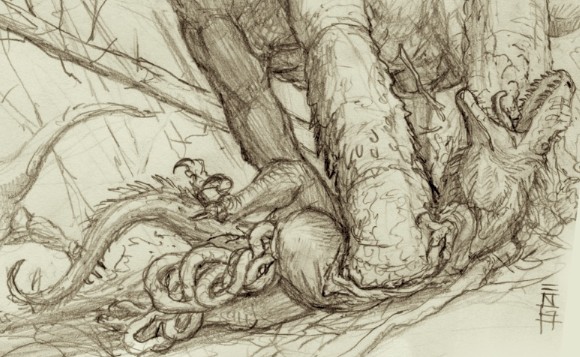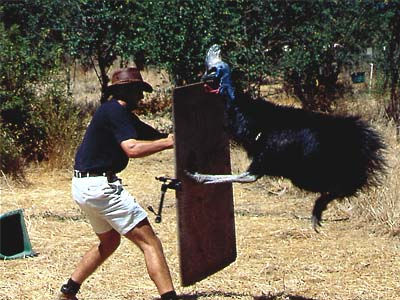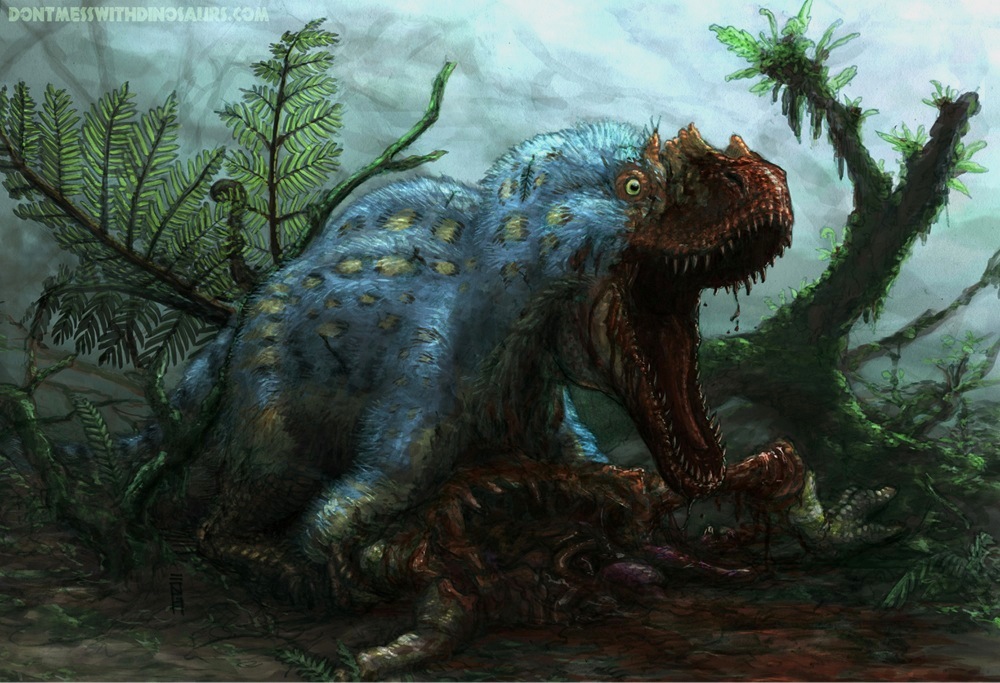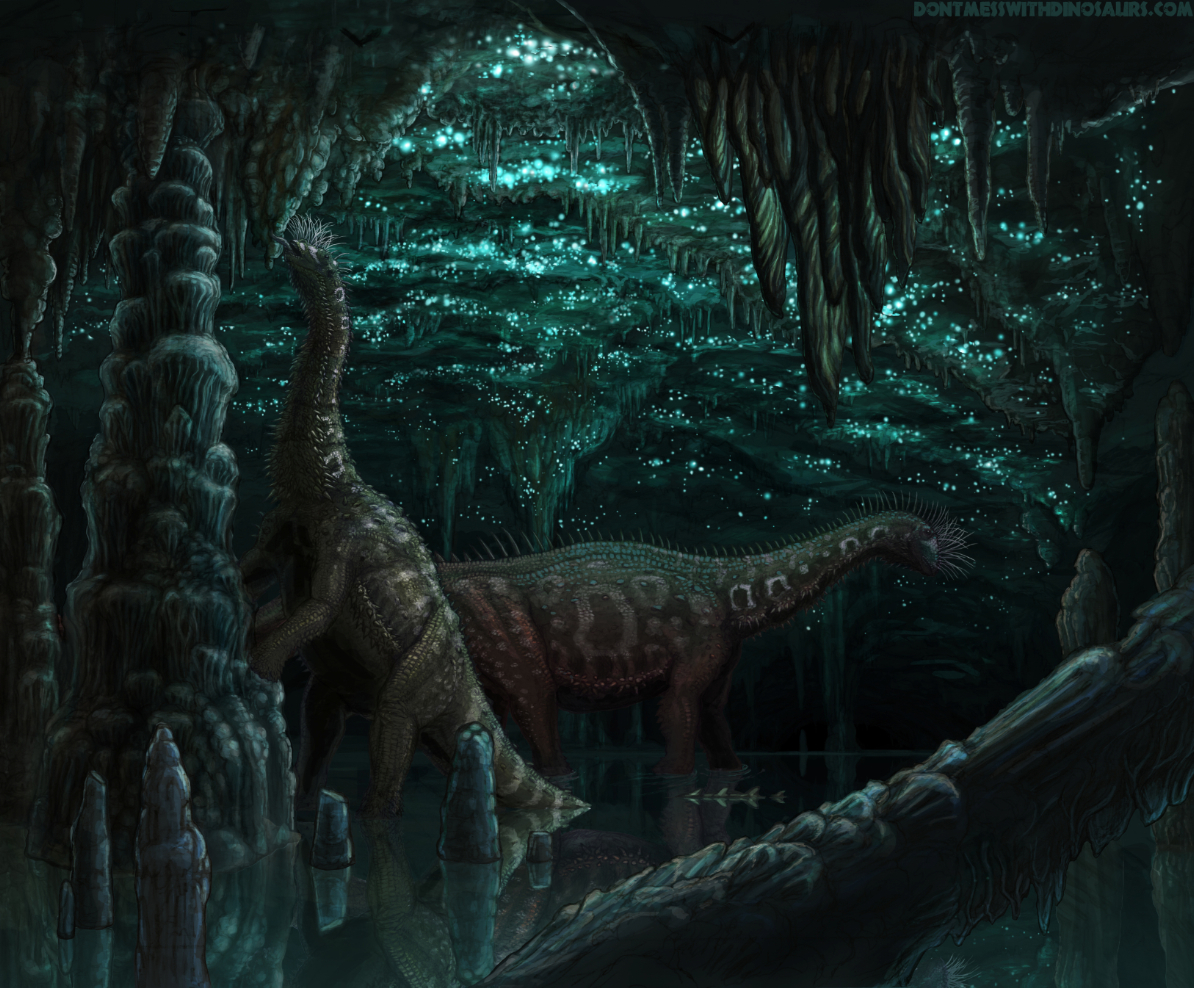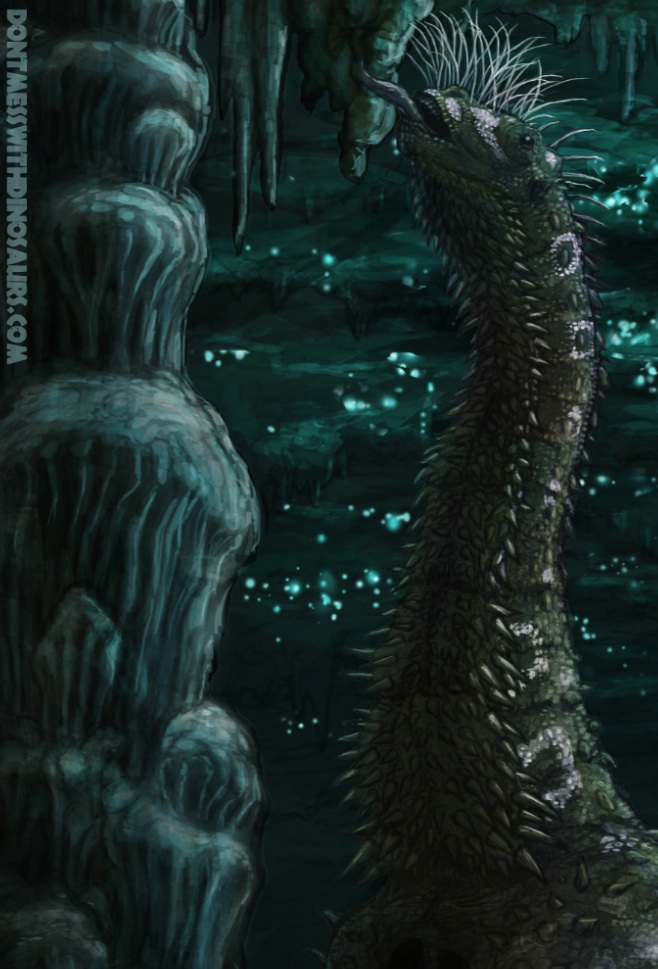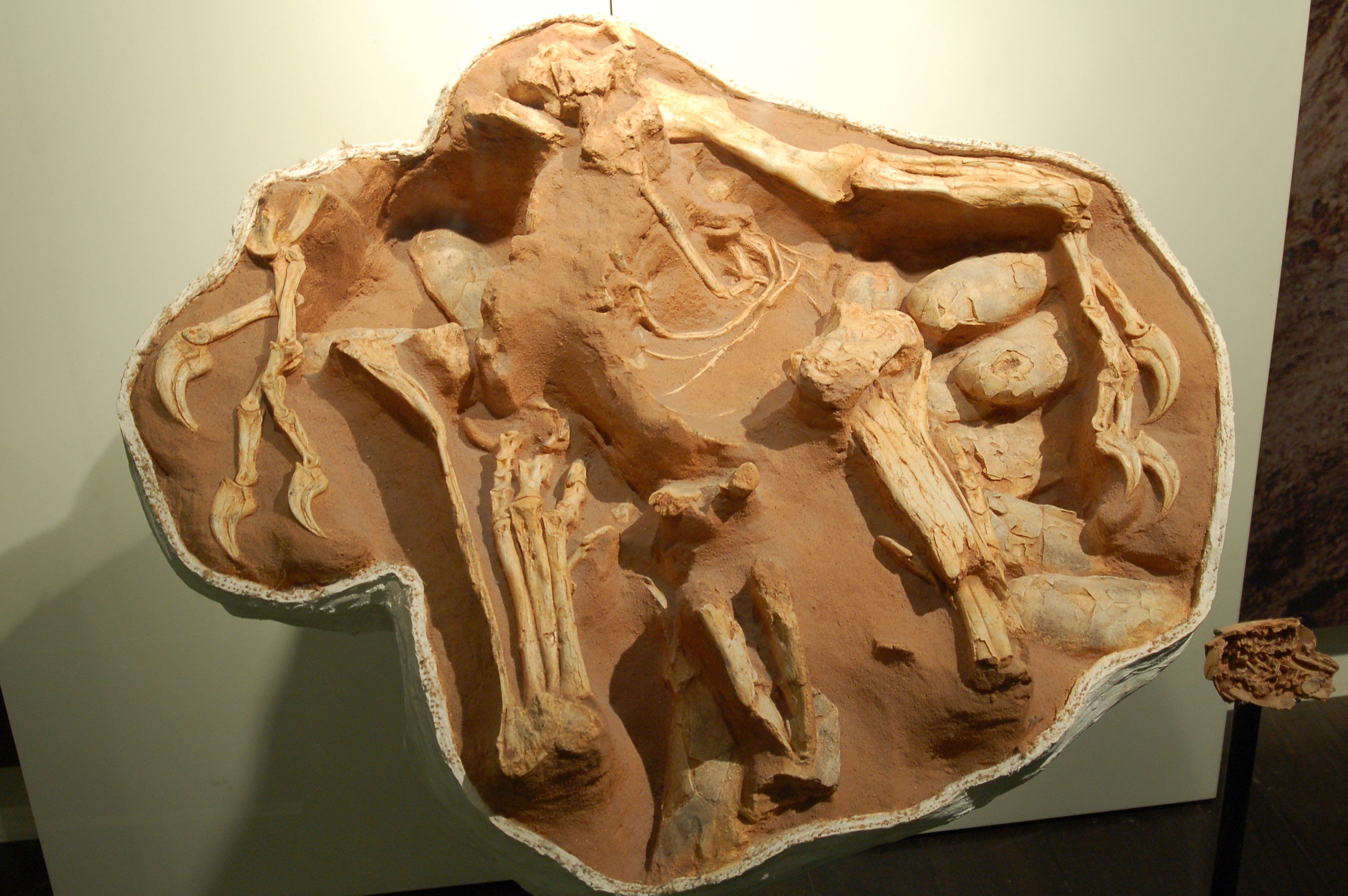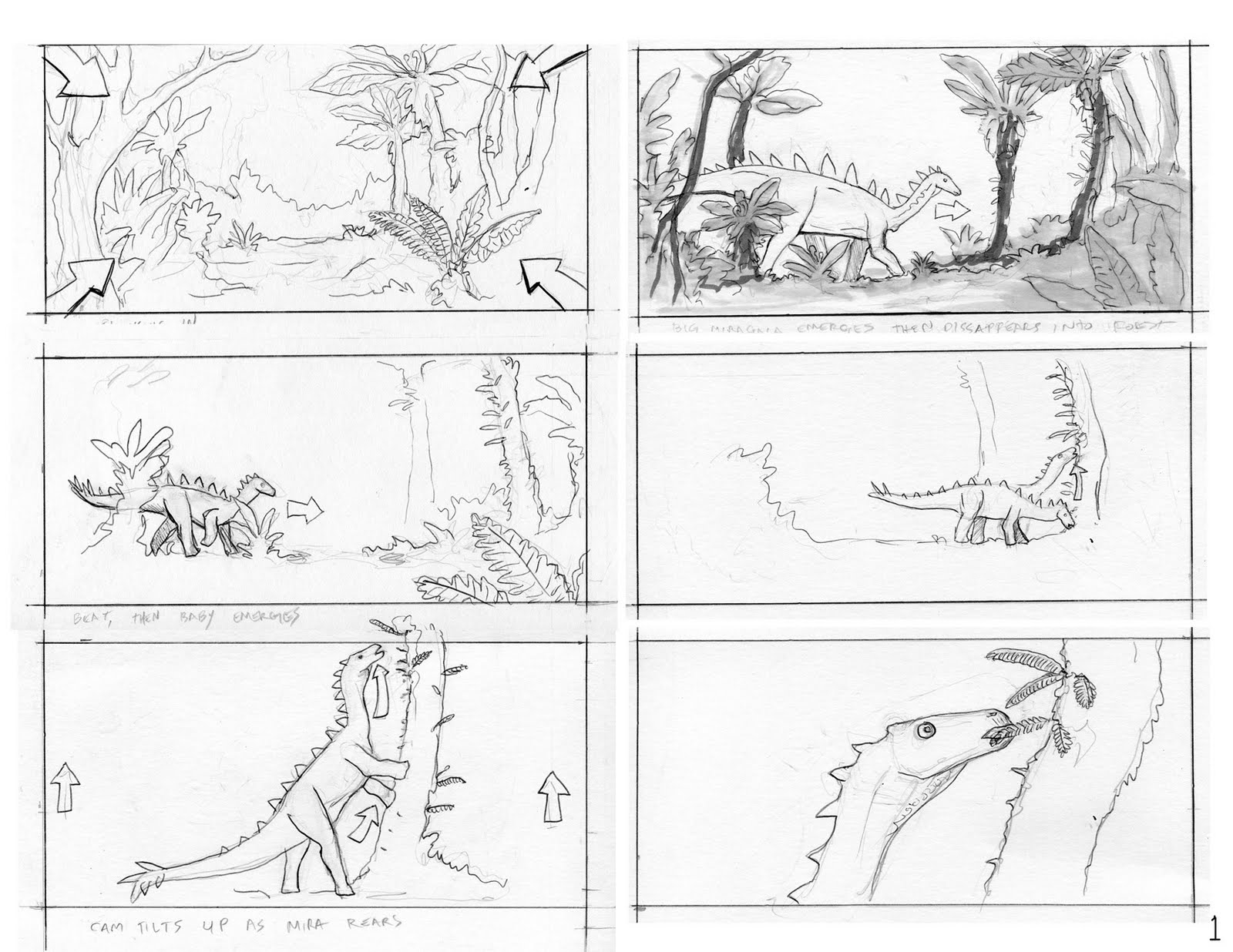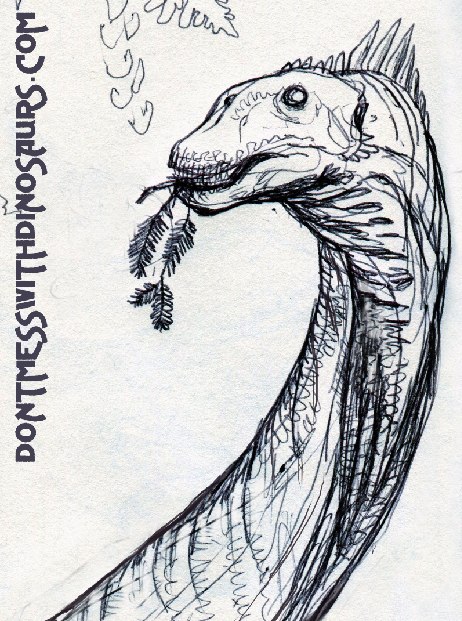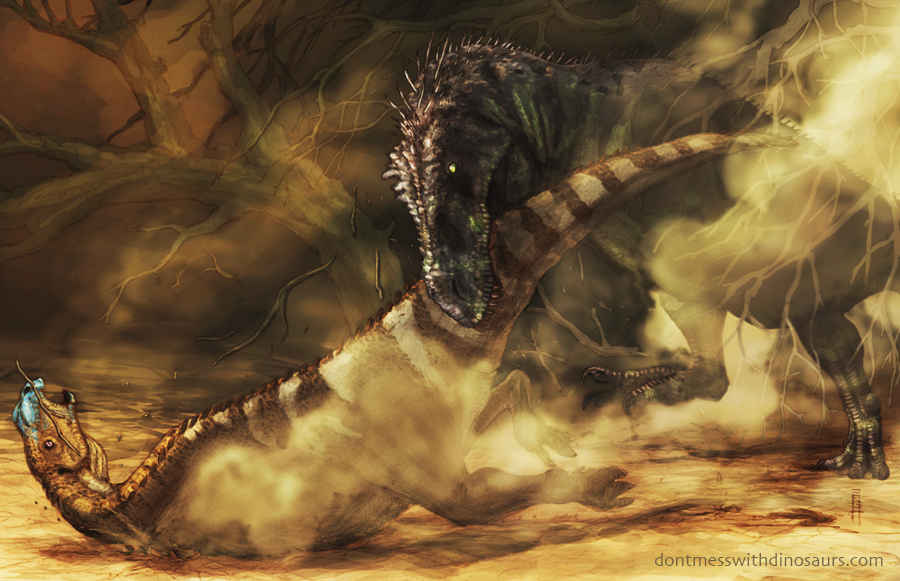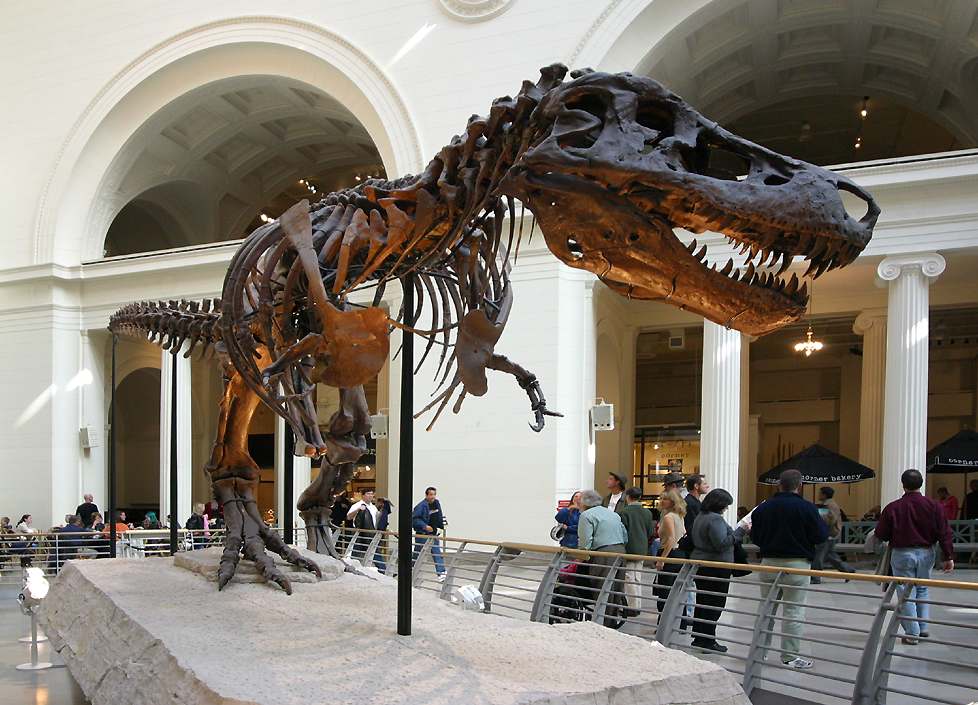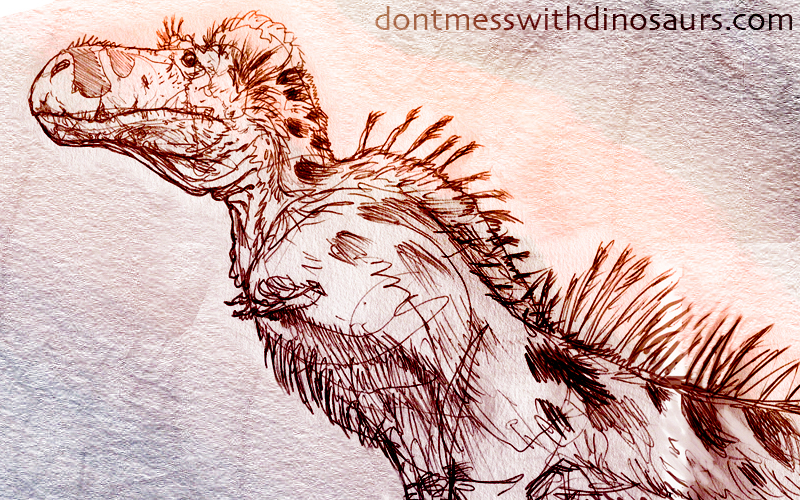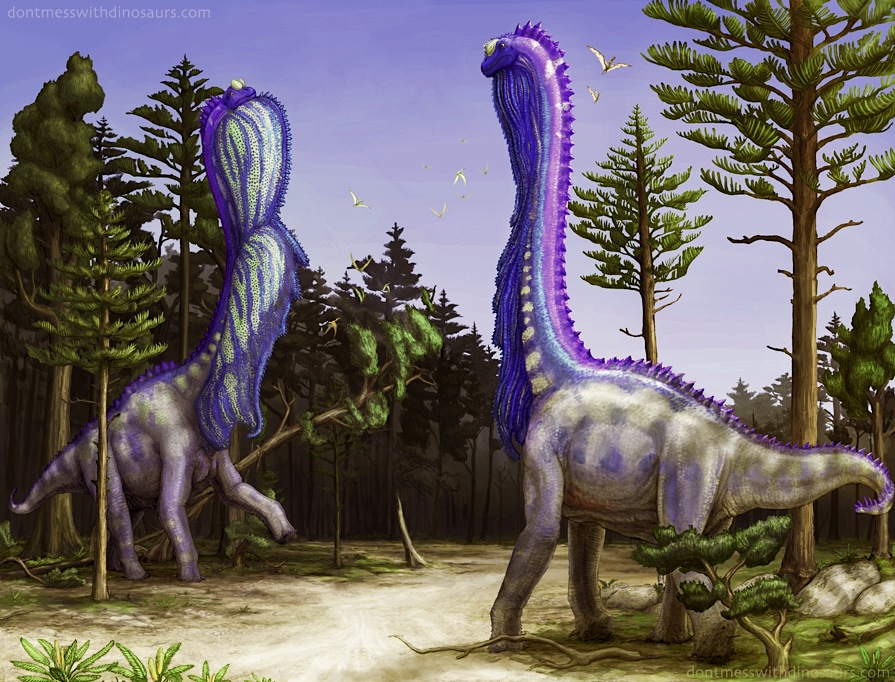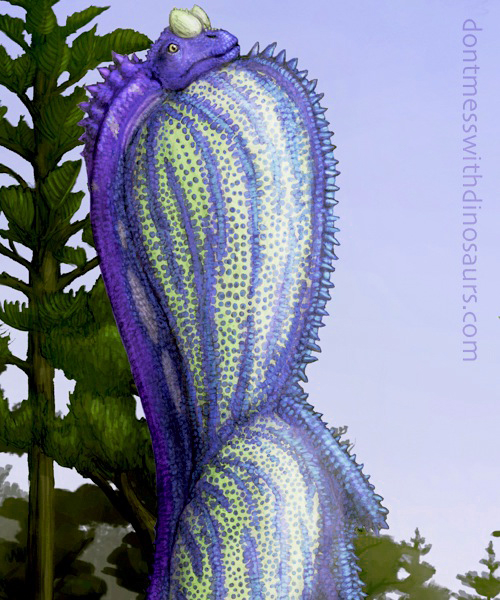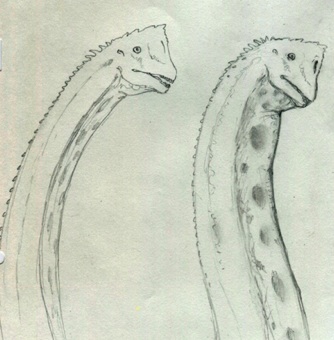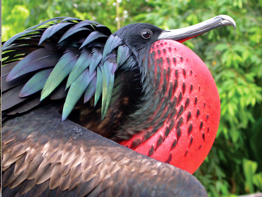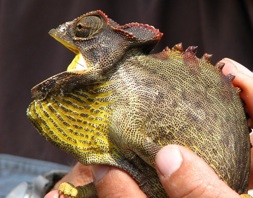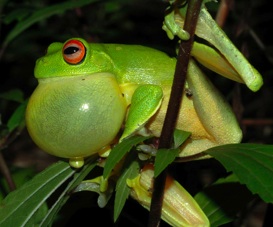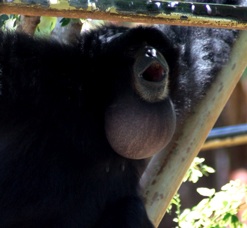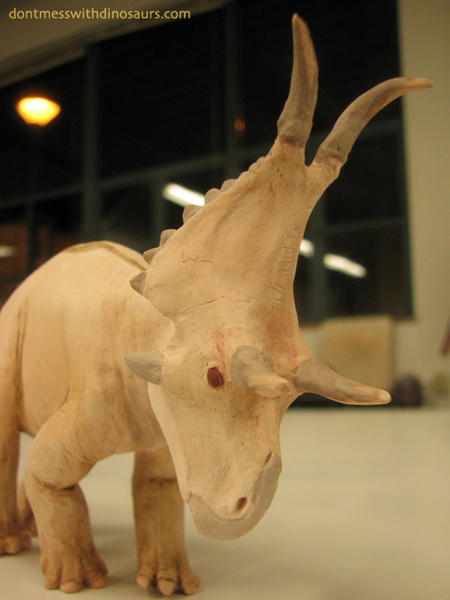Archive for the 'paleo art' Category
Feathered Dinosaurs Are Scary as Hell
There’s a bunch of squawk on the web coming from people who think that feathered dinosaurs aren’t scary. On behalf of anyone who’s had hands-on experience with or even basic working knowledge of bird biology, please, shut the fuck up. Birds are fucking creepy murderous motherfuckers. Don’t believe me? Watch this documentary in which it takes several big beefy australian rugby player type dudes to tackle down a partially sedated Cassowary which, despite being half their size, could kick their guts out.
(disclaimer: this is an hour long documentary – but if you jump to 22:25 you can see dudes tackling a drugged up dinosaur)
And that’s a fruit eating dinosaur! That’s sorta like your run of the mill Oviraptorid, except that it’s never had to run from a Dromeosaur. That’s the “Six foot turkey” the ugly fat kid in the beginning of Jurassic Park thinks ain’t shit. And it’s been roofied multiple times. And to anyone who can look at a cassowary and say “it would be scarier if it were brown and scaly like the raptors in Jurassic Park” I say that you are wrong. Not only do all those black shaggy feathers make it look like a nightmarish abomination emerging from the shadowy forest of a Jim Henson fever dream, but they also make it way harder to see which of its legs is going to kick you right in your twat. It’s like the red feathers that traditionally decorate the end of a kung fu spear to distract the opponent, except the whole animal is both feathers and kung fu and both its feet are spears.
I mean, HOLY SHIT. Indoors-only city folk who think that feathered animals aren’t/can’t be scary have clearly never spotted a barn owl with their flashlight while hiking alone at night. Let me explain: a barn owl in that context basically looks like the ghost of a dead Korean child sitting in a tree, that can turn its head completely around, fly in total silence, locate a rat by sound alone, and then snatch it with its ratchet-tendon talons from its hiding place in long grass.
Or better yet, check out a baby barn owl regurgitating the compressed bones and fur of the mammals its mother stuffed in its hook-billed squawking mouth.
Now imagine a big shaggy weirdo like that cassowary, but with the talons of an owl and it’s 20 feet long. Oh, also it has jaws with the crush force of a crocodile and the serrated teeth and septic bite of a komodo dragon. That’s what the little baby bitch cousin of T-Rex was. A murder-saur called Yutyrannus huali (which I choose to believe was named after some ancient kung fu master who could kick you hard enough to crumple your ribcage). Oh, but unlike t-rex it had relatively longer, frighteningly strong, creepy taloned hands emerging from its blood and shit flecked plumage to grip you to its fuzzy, death-smelling breast with. Don’t think that would make a horrifying mind-fuck of a movie monster?? REALLY!??!?
I disagree.
I just watched Jurassic Park in the theater for the first time in 20 years and it’s such a goddamn solid movie that it actually managed to make me mad about the recent announcement that the upcoming Jurassic Park 4 won’t feature any feathered dinosaurs. While I’m sure the new movie will have a line or two about how the JP dinos are genetic amalgams to explain away the lack of paleo plumage, what bothers me is that without a doubt the real reason for doing this is to maintain the “look of the brand”… which is exactly what the first Jurassic Park worked so hard to get away from – depicting dinosaurs according to their traditional reptilian image. The credibility and believability of the entire film is predicated on the idea that dinosaurs were more like birds than modern reptiles – from Dr. Grant’s first memorable child-traumatizing monologue to the final shots of the film which show a flock of pelicans flying along side Hammond’s helicopter as Dr. Grant smugly looks out at them like “god damn son, i really know my shit.” And twenty years later, what really holds up about the film’s dinosaurs is their distinctively bird like behavior. The tyrannosaur assaults the Ford explorer like an eagle pinning and picking apart a carcass, the raptors stalk about like huge murderous roosters, the dilophosaur has the spookily inquisitive yet suddenly aggressive temper of a cassowary, even the Brachiosaurs move and honk gracefully like a flock of giant swans. It was all thrillingly unlike anything we’d ever seen before, but despite all that, the new movie promises more of the same. That’s particularly sad when you consider that by todays scientific standards the design of the original JP dinosaurs is downright bland. Without a doubt the artistry and animation of the dinosaurs is gorgeous (especially for the time), but imagine if that level of special effects wizardry were applied to brilliantly colored and plumed creatures, reflecting our modern understanding of dinosaur soft tissues and their propensity for outlandish display structures… I submit to you, that would be visually stunning, and at times, downright frightening
…aaand here is the original frame from Jurassic park that I painted over:

Cretaceous Cavers (All Yesterdays Contest Entry)
I made this illustration for a top-secret project I’m working on in collaboration with Matt Wedel (more on that later). I also submitted it as an entry in the All Yesterdays Contest for speculative reconstructions of extinct creatures, hosted by the authors and illustrators of the book ‘All Yesterdays’.
Subadult Diamantinasaurus licking minerals in a cave illuminated by bioluminescent cave glow worms of the family Mycetophilidae.
The main idea behind this illustration is that in the 120 million years that dinosaurs ruled the earth, at some point they most likely entered caves, and perhaps even large dinosaurs entered them. As discussed on SV-POW, modern elephants enter caves to exploit their mineral resources, and it was Matt Wedel’s suggestion that perhaps sauropods also did this at some point in their lengthy natural history.
Here are some close ups of their heads and necks showing speculative scale patterning and armor, based partially on Saltasaurus, and partially on modern reptiles. The spines along the bottom of their necks and abdomens are meant to be keratinous, serving both display and defense functions, much like modern Australian Bearded Dragons (Pogona), Thorny Devils (Moloch) and the Horned Lizards of western North America (Phrynosoma). Also featured are highly reflective scales on the head and neck, similar to the modern skink Proctoporus shrevei , which may serve as adaptations for species recognition or to startle predators in low-light environments such as dark forests or caves (also, to look rad). Another speculative feature of the integument are elongated hair-like scales on the snout, which are meant to be a sensory adaptation, similar to a mammalian whisker, to help these large animals navigate in dark environments.
As I was thinking about doing this illustration, it occurred to me that it would be really cool if the cave was lit by bioluminescence, and after a little research I learned that the glow worms that light up caves are from the genus Arachnocampa and are native to Australia, New Zealand and Tasmania. Arachnocampa are part of a big diverse group of gnats called fungus gnats – family Mycetophilida – that were “well established and diversified by the Cretaceous period at the latest (wikipedia)”. Geology, fossil evidence, and shared flora and fauna all suggest that New Zealand and Tazmania separated from Australia toward the end of the Cretaceous. Thus, the modern geographic range of these glow worms suggests that they were present on the Australian continent toward the end of the age of dinosaurs when New Zealand and Tazmania separated. Thus it seems entirely possible these strange glowing insect larvae illuminated caves that the dinosaurs of Mesozoic Australia wandered into…
The dinosaurs in the illustration are based on the highly fragmentary Diamantinasaurus, because they lived in ancient Australia, and because they were possibly armoured like their close relatives Saltasaurus. I thought it would be cool to draw a speculatively armored sauropod because, 1) armor looks rad, and 2) armor requires a lot of minerals (especially calcium) to grow. In the case of Saltasaurus, the armor is a series of bony knobs called osteoderms, which start as keratinous scales, that are reinforced with bone as the animal grows. That inspired me to speculate that perhaps during the phase in their life where they are rapidly growing and hardening their integument, they made a habit of visiting caves to boost up on calcium and other important trace minerals not easily acquired elsewhere. This caused me to begin speculating as to what other adaptations dinosaurs who frequently ventured into caves might’ve developed as they became more and more specialized for dark environments. If indeed, venturing into caves became an essential part of these animals’ life cycle, perhaps then they would have evolved such features as the whisker-like scales on their faces and the reflective display scales I depicted them with on their heads and necks. It seems to me that if the diversity of dinosaur integuments seen in the fossil record is to inform how we imagine the skin features we can’t see in the fossil record, we should imagine dinosaur skin texture and function as diverse and highly adaptable. Growing fossil evidence suggests that the adaptive flexibility of dinosaurs’ skin and scales were a significant factor them so successful for so long. Even just within the theropods we see everything from scales, to osteoderms, horns, fuzz, feathers, quills, exposed bare skin – and often with several of these different features within the same animal.
But who knows… While fossils of large animals are known from ice age caves, I don’t know of any Mesozoic fossils coming from cave systems. Perhaps most cave systems are too unstable to last so long as to survive from the mesozoic to the present, or perhaps we just haven’t been looking in the right places. Based on modern animals, I think it’s safe to assume that dinosaurs and other mesozoic monsters colonized and exploited cave environments, perhaps even adapting into obligate cave dwellers, whose bizarre remains lie undiscovered in some hidden cavity in the geological bowels of the earth…
Oh, and here is the pencil drawing of the above illustration before it was colored:
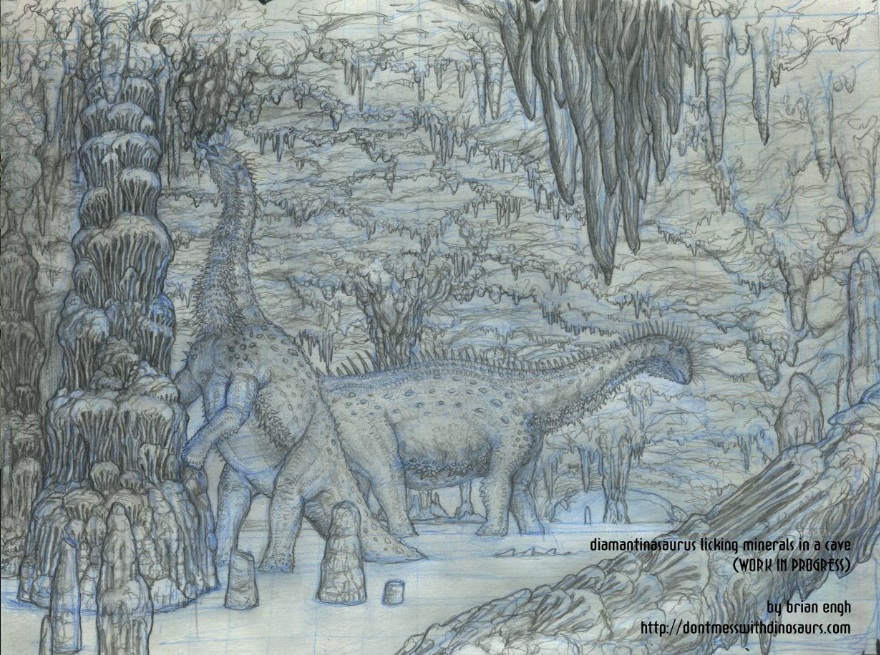
“Textured 2d” Cryolophosaurus Animation
This animation was created by first making traditional hand-drawn 2d animation, and then by digitally animating detailed textures (both hand drawn and digitally painted) in such a way that they match the movements of the hand drawn animation. As far as I know, 2d animation has never been done in quite this way before.
This is my first test animation, and although the techniques and look of the animation will have to be refined with successive animation tests, I am really happy to have come up with something that I think works pretty well, looks neat, and is different than anything I’ve seen before. I am excited to continue to explore the possibilities of combining 2d hand drawn animation with digital tools, and I hope you will stay tuned and give feedback as things evolve.
Dinosaurs Reanimated
So here’s the deal: I’m fucking bored with all the CG dinosaurs running around on the TV box these days. So I’m teaming up with some dino buddies and we’re making a spec doc that we’re going to try to develop into a TV series. I’ve created a blog where we’ll be putting various production materials and giving/getting feedback. Check it out, read our mission statement, RSS it, and let us know what you think as we put stuff up. We’re open to ideas and we hope you’ll hold us to a high standard of quality and scientific accuracy:
Dinosaurs Reanimated Production Blog
Yeah, yeah I know, CG dinosaurs sometimes ‘look cool’ but very very rarely move well or act like real animals. Furthermore the docs that feature the CG dinos often present speculation as fact, make stupid shit up, and just strait up get stuff wrong. I call it ‘bullshitting’, and I generally don’t like motherfuckers who do it, especially to children.
Turns out, I’m not entirely alone in my weariness of CG and bad paleo docs. Paleontologists galore are also often regularly frustrated and disappointed by the shows they often advise on but have too little say in the creative process to be able to do anything much but blog about it. They work hard to discover rad stuff, and then give their time and energy advising on documentaries who often ignore what they say or even actively misrepresent them. It sucks.
On top of that there’s a diversity of talented animators out there who are skilled in a variety of mediums, who understand behavior, story and the drama of survival, and who could make much more interesting animation than the void-of-substance CG that has risen to ubiquity in recent years. With the advent of digital technology the push has been to digitize as much of the workflow as possible, and aim at an impossible level of ‘photo realism’ instead of figuring out interesting ways to hybridize and streamline beautiful traditional techniques with digital technology to (perhaps even more efficiently) present original art to the public. And that’s the thing – it’s all just ‘art’. It’s never going to look like the real animals because nobody’s ever seen the real animals. And from what I can tell, the only visual goal of ‘photorealistic’ CG is to try and look like something real THAT NOBODY’S EVER SEEN. That’s just fucking dumb. Stop wasting all that time and money.
Ultimately, what compels me most is that there are more certain truths about dinosaurs and other extinct animals that these docs could elaborate on in a gripping way, but that are completely overlooked in favor of that ever elusive “cool factor”. What I’m talking about is the fact that these were real animals, that went through gnarly harrowing shit in order to survive for millions and millions of years. They were parents, hunters, victims of natural tragedy and witnesses to the incredible beauty and vivacity of life. They struggled with so many of the same basic challenges that we do; trying to find food, a mate, a safe place to live, and they dealt with these challenges in amazing brilliant ways, many of which are actually recorded in the fossil record!
Thanks for reading. If you have the time, check out our production blog – we need your critical input!
don’t mess with prehistoric fish, either.
Serious paleo warriors know about prehistoric fish (and that they’re awesome). Either way, I’ve got good news for you. This previously undescribed Lepidotes sp. that I illustrated alongside Cladocyclus pankowskii a few months back…
…has been formally described in the current issue of Paleo Electronica. It now bears the specific name Lepidotes pankowskii (again, after Mark Pankowski who bought and donated the type specimen). Nice.
If anybody else has new species that have never before been illustrated (or named yet) get at me. I’m here for that.
In other prehistoric fish related news, some species of prehistoric fish never went extinct, and can be bought at your local pet store for $5.49. I just got a Polypterus senegalus (aka Senegal Bichir) – cogenerics of which have also been found in African Cretaceous rocks. I have it in a tank with a Xenopus frog (also cretaceous), and it’s been really fun to watch the two of them lurk around and eat earthworms together.
The polypterus uses it’s big front pectorals to sort of hover across the bottom or to weave its way through aquatic vegetation and up the water column to investigate delicious smells. It seems to only use it’s caudal fin for bursts of speed when attacking prey or evading a perceived threat (usually me maintaining the tank). It’s really fascinating to observe a working body plan derived from somewhere near the base of the branch on the tetrapod family tree that would eventually give rise to all terrestrial vertebrates.
I love that there are a few extant species that have remained virtually unchanged for millions of years. I like to think of them as some kind of an ‘entry point’ into imagining the ancient world. I feel like if I can understand these animals, then I can begin to take steps away from them, towards the more mysterious creatures they shared their world with that have left us only fossils.
What in Hell Creek is a T. Rex?
Seriously. What is this animal?
A few months back I did this illustration of T. rex ambushing a Hadrosaur, inspired by evidence that Tyrannosaurs bit the tails of living Hadrosaurs. I decided to keep the attacking T. rex mostly obfuscated by a cloud of dust partially to give the impression that the Hadrosaur was ambushed as its herd stampeded past a hidden Tyrannosaurus, but also because this mighty predator is a mystery to me.
I was recently at the Field Museum in Chicago looking at Sue again in person, and as I gazed up into that huge bizarre skeleton, I could not ignore an unsettling idea prying at somewhere deep in my childhood psyche: This is not Tyrannosaurus Rex. Those bones were from something different. A creature foreign and bizarre to me from a different world. An animal that looked, moved and fought for survival nothing like what I had grown up imagining as Tyrannosaurus Rex.
For a few years now I’ve been trying to come up with a satisfying reconstruction of a big adult T. Rex but I still haven’t managed one, and in my opinion, none exists from another artist. The necks, legs and tails are all too long, slender and bird-like, the body cavity not deep nor tall enough, the arms too developed looking. I feel like every paleo-artist (including myself) is trying to reconcile the actual skeletal proportions of big Tyrannosaurs with the idea of these animals that the film Jurassic Park made so visually concrete and believable. We want to imagine big Tyrannosaurs as agile hunters chasing down their prey, engaging it in combat, and dispatching it with fatal bites. While some of the smaller species of tyrannosaurs, and the juveniles of T. rex may have been relatively long-legged, the really big ones – the ones we base epic illustrations on – simply weren’t. When I look at the skeletons of the big adult Tyrannosaurs I see a hulking beast with a HUGE body cavity, a massive tail and head, and relatively short thick legs. And yet we have evidence that these massive predators attacked formidable living prey. So what the hell is this animal? How did it live, hunt, and sustain its enormous bulk?
In short, I do not see an agile jungle cat. I see something like an obese crocodile on two thick chicken legs.
I have been kicking around a few ideas for tyrannosaur illustrations (including a reconstruction of Sue) that I want to do in the coming months as I am able to find the time. I know a feathery body covering to the extent that I have drawn in the above doodle is not likely considering scaly skin impressions of tyrannosaurus have been found, but I have been experimenting with different soft tissue reconstructions with the hope of coming up with some new looks for this old giant. Ultimately my aim is to produce some reconstructions that are true to the fossil evidence while at once dramatically depict this seemingly mythical creature as a something more of a real, believable animal.
I think one of the main reasons why dinosaurs (and other extinct monsters) are so awesome is that we can keep imagining new ways they might have been awesome, and ultimately its a pretty safe bet that when these animals were alive they were more awesome than anything we’ve yet come up with. Nature tends to be pretty kick-ass that way.
Ever seen a fossil nautilus?
Sauroposeidon proteles Reconstructed
Brachiosaurs were big. Maybe too big for camouflage.
When I look at illustrations of dinosaurs, even very technically good ones, I’m often left with the uneasy feeling that it just doesn’t ‘feel’ like a real animal. Its as if only two simple layers have been added to the still-recognizable skeleton – while living vertebrates often look nothing like their skeletons. This has compelled me to try and push my dino reconstructions beyond just draping skin and major muscle groups over the skeleton. I want to see them come alive, living and breathing beings with muscle, cartilage, circulatory systems, fat, skin, feather, hair, horn, complex eyes, and, as in this case, elaborate display structures.
This illustration was inspired by the work of paleobiologists Matt Wedel, Mike Taylor and Darren Naish who write two of the best paleo blogs on the web, Sauropod Vertebrae Picture of the Week (SV-POW!) and Tetrapod Zoology (Tet Zoo). They are also badass paleobiologists who not only dig up fossils and study dinosaurs, but also spy on them, dissect them, and mail order their severed heads to skeletonize them. I have also heard rumors that they are working on a time-traveling three-part combining robot machine and have lazer gunz (this, however is not officially confirmed).
Their blogs contain a wealth of information and discourse invaluable to any artist trying to reconstruct dinosaurs, especially sauropods. On Darren Naish’s blog, Tet Zoo, I found an informative and easy-to-read post describing how to best reconstruct the manus (hands) of sauropods, which I referenced frequently while reconstructing the stompers on my Sauroposeidon.
The elaborate display structures were inspired by various posts on SV-POW from which I learned that sauropods have highly pneumatic skeletons. This means there are air sacs and hollows throughout their skeletal systems much like a bird’s. These skeletal features suggest that Sauropods also had complex respiratory systems, also like those of modern birds. When I learned that, I got very excited, because birds don’t just use their wacky respiratory systems for breathing, they also use them for inflating crazy display structures. With that in mind I did this rough sketch:
Matt Wedel has done a bunch of work studying pneumaticity, especially with regards to sauropods, and he was nice enough to take a look at my rough sketch and give me some feedback:
“I think it rocks. But not nearly enough. Look up some pictures of prairie chickens, hooded seals, singing frogs, and everything else with inflatable display sacs. They don’t look like they just swallowed a stick of Mentos–they look like freeze-frames from half a millisecond after the the detonation of that bomb they swallowed. Real display sacs are so big and so colorful that no other animal could possibly mistake them for anything else. Therefore if you want to draw speculative display sacs they must be so big and colorful that none of the people who see the piece could possibly mistake them for anything else.”
And he’s totally right. Real animals are ridiculous.
Our conservative reconstructions simply don’t do extinct monsters justice. Or, as Matt put it in the same email:
“If you go bold, you won’t be right; whatever you dream up is not going to the same as whatever outlandish structure the animal actually had. On the other hand, if you don’t go bold, you’ll still be wrong, and now you’ll be boring, too.”
Kilnloads o’ Dinos
Hey so I haven’t posted much progress on my ceramic sculptures because I’ve been really busy finishing them by the firing deadline. Here’s what the loaded kiln looks like:
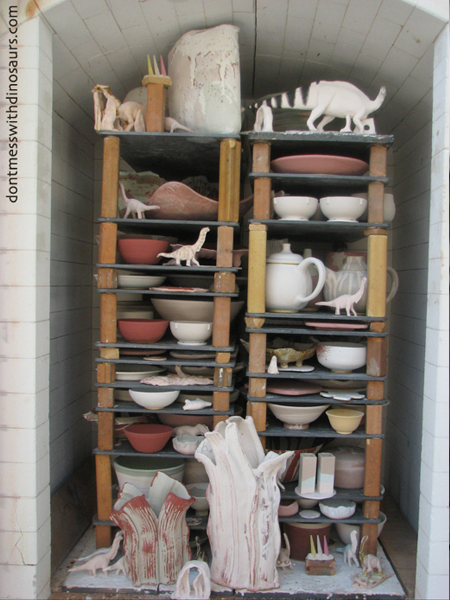
How many dinosaurs can you find?!?!
Well… in addition to the Majungasaurus I posted earlier I created a similar sized Parasaurolophus cyrtocristatus and a slightly smaller Diabloceratops eatoni (shown here as unfired clay sculptures).
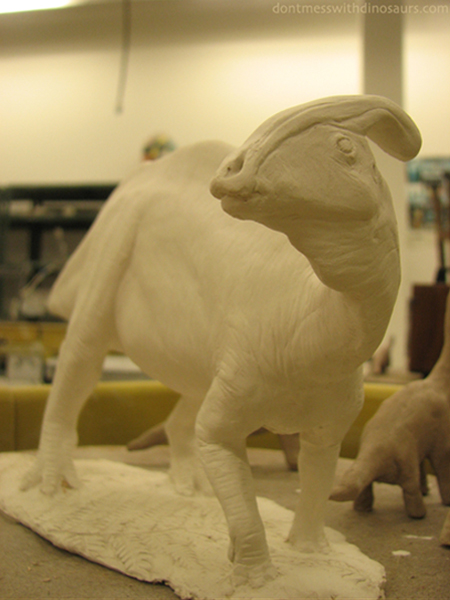
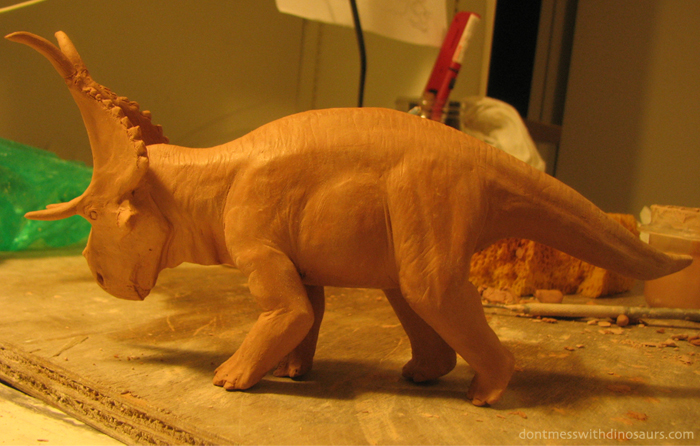
I also created a small brachiosaur model from which I created two rubber molds. From those rubber molds I cast about 25 little brachosaurs…
All of that since last Friday (7/23), with enough time to dry for their first firing by the following Wednesday (7/28). After that first firing the pieces are glazed and/or stained and then loaded into the kiln pictured above for their final high firing (which will turn them into rocks). So yeah, I’ve been real busy!
Here’s my Diabloceratops after being fired for the first time, now with a bit of glaze applied to its horns and some mineral stain on its eyes and back:
What’s this? Two firings? Yeah. Once the clay sculpture is completely dry it is fired for the first time to 1825 degrees. This is called the bisque firing. Bisque firing causes the clay particles to melt just enough to bond the form into a porous terra-cotta like substance. We bisque for several reasons. Primarily, it transforms the brittle dry clay into a more durable substance that is no longer water soluble (unlike clay, which turns to goop when soaked with water.) Also this porous low-fire pottery readily absorbs water. This allows us to apply glazes. Glazes are basically powdered glass, clay and mineral colorants which we mix with water. When we dip or paint or spray this glaze mixture onto our bisque-fired pieces, the porous bisque-ware absorbs the water and causes the glaze particles to stick to the form. Or, as my friend Drew explains it; you know when you throw wet mud at a brick wall and it sticks even after the mud dries? Same concept.
See how the color has changed since before it was fired? It’s going to change much much more. In the second firing temperatures inside the kiln will reach over 2300 degrees F (lava temperature) and the clay particles will become red hot and semi-molten. The form will become denser as minerals vapourize and the clay particles slowly flow together, closing tiny pores and fissures once present in the bisque-ware. Glazes will become completely molten and they will move. The mineral colorants in both clay and glaze will go through the complex chemical reactions that will ultimately give them their final color. And each firing it is a little different. Subtle variations in the chemistry of both the piece being fired, and the kiln environment it’s being fired in can have drastic effects on the look and feel of a piece.
Even the most ancient and experienced ceramists will acknowledge that the results of a firing are never completely predictable. As the kiln door closes we must let go of our work in this final crucial stage of its development to mature without us. If we have not done our work well the laws of physics which govern this art will show us what we have actually created. And if we have done our work well, with attention to detail and upon good instinct, our sense of aesthetics will speak through the form, sometimes in unanticipated and surprising ways.
Now, we can only wait.
